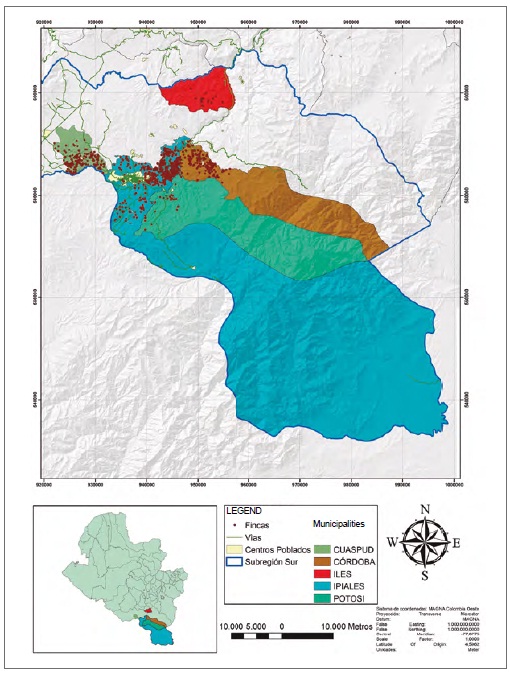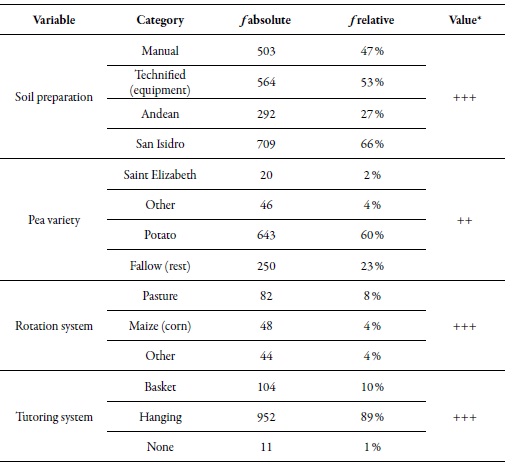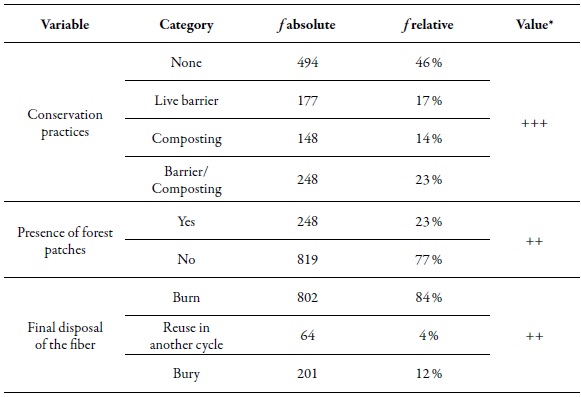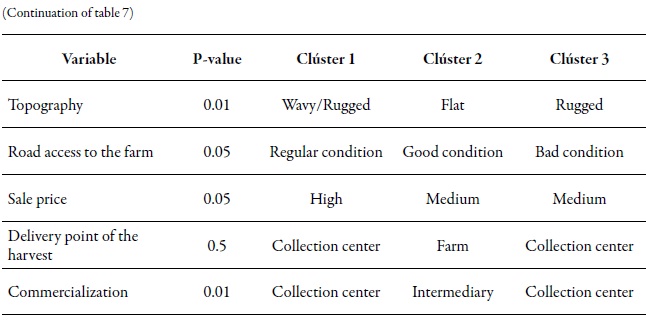Servicios Personalizados
Revista
Articulo
Indicadores
-
 Citado por SciELO
Citado por SciELO -
 Accesos
Accesos
Links relacionados
-
 Citado por Google
Citado por Google -
 Similares en
SciELO
Similares en
SciELO -
 Similares en Google
Similares en Google
Compartir
Ciencia y Tecnología Agropecuaria
versión impresa ISSN 0122-8706versión On-line ISSN 2500-5308
Cienc. Tecnol. Agropecuaria vol.20 no.3 Mosquera sep./dic. 2019 Epub 10-Sep-2019
https://doi.org/10.21930/rcta.vol20num3art:1593
Sistemas de información, zonificación y georreferenciación (agricultura de precisión)
Typology of pea-producing farms (Pisum sativum L.) in the southern subregion of Nariño, Colombia
1Estudiante PhD., Universidad Nacional de Colombia, Facultad de Ciencias Agropecuarias, Doctorado en Agroecología. Palmira, Colombia
2Docente, Universidad Nacional de Colombia, Facultad de Ciencias Agropecuarias, Departamento de Ciencias Biológicas. Palmira, Colombia.
3Docente, Universidad de Nariño, Facultad de Ciencias Agrícolas, Departamento de Recursos Naturales y Sistemas Agroforestales. Pasto, Colombia.
In Colombia, Nariño is the main pea-producing department that supplies approximately 54 % of the national demand. The main producing area of this legume is concentrated in the Obando or southern subregion of the department, where pea (Pisum sativum L.) shows adequate environmental conditions and develops under family farming. In this study, we sought to identify typologies of farms dedicated to this crop, for this, a heterogeneous sample of 1.067 farms in five municipalities of the southern subregion (Córdoba, Cuaspud, Iles, Ipiales and Potosí) was taken. Following the methodological framework proposed by the International Network of Research Methodologies in Production Systems (rimisp, for its acronym in Spanish) to georeference each farm and apply a structured survey with 39 variables. The information obtained was subjected to Multiple Correspondence and Hierarchical Grouping Analyses. As a result, 12 variables with discriminant power were identified, which formed three clusters: C1 grouped 6 % of the sample (68 farms), C2 assembled 26 % (271 farms) and C3 grouped 68 % (728 farms). Each group showed particular characteristics regarding the property, agro-productive strategies, and social, environmental, and economic aspects that described the heterogeneity of the farms associated with pea cultivation. It is expected that the results will contribute to the characterization and selection of representative farms for future sustainability estimation works.
Keywords agroecology; family farming; legume; multivariate analysis; pilot farms; typification
En Colombia, el departamento de Nariño es el principal productor de arveja (Pisum sativum L.) abasteciendo aproximadamente el 54 % de la demanda nacional. La principal zona productora de esta leguminosa se concentra en la subregión Sur u Obando del departamento, en donde el cultivo presenta adecuadas condiciones ambientales y se desarrolla bajo agricultura familiar. En este estudio se buscó identificar tipologías de fincas dedicadas al cultivo, para lo cual se tomó una muestra heterogénea de 1.067 predios ubicados en cinco municipios de la subregión Sur (Córdoba, Cuaspud, Iles, Ipiales y Potosí); siguiendo el marco metodológico propuesto por la Red Internacional de Metodologías de Investigación en Sistemas de Producción (rimisp), se georreferenció cada finca y se aplicó una encuesta estructurada con 39 variables. La información obtenida fue sometida a Análisis de Correspondencia Múltiple y Análisis de Agrupamiento Jerárquico. Como resultado se identificaron 12 variables con poder discriminante que conformaron tres clústeres: C1, que agrupó el 6 % de la muestra (68 fincas); C2, el 26 % (271 fincas), y C3, el 68 % (728 fincas). Cada grupo presentó características particulares en torno al predio, estrategias agroproductivas, aspectos sociales, ambientales y económicos, describiendo la heterogeneidad de las fincas asociadas al cultivo de arveja. Se espera que los resultados contribuyan a la caracterización y selección de fincas representativas para futuros trabajos de estimación de sustentabilidad.
Palabras clave agricultura familiar; agroecología; análisis multivariante; fincas experimentales; leguminosa; tipificación
Introduction
With a harvest of 30,000 t per year and an approximate area of 14,103 ha, the department of Nariño is the main pea-producing region in Colombia. It is estimated that 20,140 farmer families depend economically on this crop, generating 1.5 million wages per year (Departamento Administrativo Nacional de Estadística [dane], 2011; Ministerio de Agricultura y Desarrollo Rural [madr], 2018).
On the other hand, it should be noted that between years 2000 and 2017 the area planted with peas increased by 3.9 times (9.230 ha) and the average yield rose from 5.1 to 7.2 t/ha (MADR, 2018). In that sense, a rapid expansion of pea cropping has replaced crops like potato, maize, pastures, wheat, and other traditional vegetables, particularly in thirteen municipalities that are grouped in the southern territorial subdivision of the department, also called the Obando subregion. This phenomenon coincides with the reinforcement of technological packages that use improved varieties, high demand for external inputs (fertilizers, pesticides, and fuels, among others) and tutoring to express their maximum agronomic performance.
As a consequence of the above, pea has modified the landscape and production characteristics of farm systems in this subregion, causing pressure especially on natural resources, which makes it necessary to identify and study the diversity associated with the crop and establish, from the heterogeneity viewpoint, strategies that allow evaluating and increasing sustainability.
The farm as a unit is generally associated with a measurable surface (property), managed by a family that has an agricultural purpose and linked, in turn, with the physical, biological and socioeconomic processes of the region, which limit or promote the use and change in soil cover (Hart, 1985; Madry, Gozdowski, Roszkowska, Dabrowski, & Lupa, 2010; Madry et al., 2013).
In practice, it is challenging to study in depth each farm in a region, so it is necessary to use alternative methodologies and approaches to address this problem.
The analysis of agricultural typology offers a possible solution, which simplifies the enormous diversity in complex systems (Goswami et al., 2014), building clusters (groups) that involve the creation of a taxonomy of farms or the so-called recommendation domains, i.e., an approximately homogenous group with similar circumstances to which a similar recommendation can be made (Escobar & Berdegué, 1990; Lores, Leyva, & Varela, 2008).
In typology studies, two main methods can be distinguished: i) a priori research based on knowledge and the judgment of the researcher, and ii) quantitative typing based on statistical analysis (Dos Santos, 2013, Goswami, Chatterjee, & Prasad, 2014). For the latter, a large number of variables and multivariate statistical techniques are generally used to reduce the dimensionality of the information and group the farms according to decisive features.
Each group of farms will be related to the structure, technology, social relationships, values, planning and objectives of the farmers that comprise the system (Madry et al., 2013), allowing the heuristic conceptualization of the classification subject, and in many cases, proposing methodical approach strategies.
Accordingly, the aim of this study was to establish a typology of pea producing farms in the Obando southern subregion of the department of Nariño, Colombia, to contribute to the characterization and selection of representative plots for future sustainability estimation works.
Materials and methods
Study area and farms selected
This study was carried out between February and April 2017 in the Obando or southern subregion of the department of Nariño, Colombia. A heterogeneous sample of 1,067 farms was selected in the municipalities of Ipiales (633), Córdoba (199), Cuaspud (194), Potosí (27) and Iles (14); these were chosen as they are the leading pea-producing municipalities at the departmental level.
Pea cultivation system
Pea cultivation in the study area is transient and associated with family farming, with a productive cycle between 3.5 and 4 months. The plant is herbaceous, belonging to the Fabaceae family, and Papilionoideae subfamily. The production is continuous throughout the year, being cultivated in the Andean region usually in cold and moderate-cold climates.
Characterization and typification of farms
The methodological proposal of the International Network of Research Methodologies in Production Systems (rimisp, for its acronym in Spanish) for land classification was used (Escobar & Berdegué, 1990). For the collection of information, the structured survey technique was used, whose questionnaire was elaborated with 39 primary variables: five quantitative and 34 categorical variables, grouped into four components; the selection of these variables was based on classification and consultation works with experts in pea cultivation.
The requirements to apply the survey in the field were the following: a) the farm cultivates peas as the main crop with a proportion of the area higher than 40 %, and b) that 70 % or more of the family income was derived from the agricultural activity.
Georeferencing farms and information gathering
An interview with the person making the operational decisions in each of the 1,067 farms visited was performed, coding the survey to consolidate the information in a general matrix. Jointly, each property was georeferenced using the Garmin 12XL gps equipment (error ± 5 m).
Selection of variables with discriminant power
The analysis of the five quantitative variables was carried out by establishing the coefficient of variation and discarding those that showed a value lower than 40 %, as suggested by Lores et al. (2008). The 34 categorical variables were evaluated independently by qualifying their discriminant power, as follows: high (+++) if the variable showed a disaggregated distribution in the proposed classes; medium (++) if the variable had a connection with another variable or it can be excluded; and low (+) if the frequency has a tendency towards a specific class. These primary methods of reducing statistical variables allowed operating the Multiple Correspondence Factor Analysis (mca), decreasing the dimension of the information that would be classified.
Cluster establishment and description
Once the factors resulting from the mca were selected, a multivariate analysis of Hierarchical Grouping was developed, using the Ward Algorithm method, through which a dendrogram was obtained, and where the number of clusters was identified. For the description of the pea producing farms, the variables were selected using the deviation method between the values relative to the class and the global values using the P-value test (P-value < 0.05). The FactoClass library of the software R v.3.2.2® (R Development Core Team, 2013) was used to carry out the statistical analyses.
Results and discussion
Georeferencing farms and information gathering
The characterized farms were located between 1,829 and 2,847 m above the sea level. The spatial distribution varied between -77.8 and -77.4 degrees of longitude and 0.9 to 1.6 degrees of latitude. The totality of the georeferenced points was grouped as a homogeneous biophysical unit when merging the coordinates with the land use suitability map (agricultural use). Figure 1 shows the spatial distribution of the 1,067 points in the five municipalities studied.
Selection of discriminant power variables
In table 1 are shown three quantitative variables that had a coefficient of variation higher than 40 %; the variables altitude (m a.s.l.) and several production plots were discarded, given that these did not show a reasonable variance within the farm samples surveyed.
In tables 2 to 6 are shown the results of the variables that were selected for their high and medium discriminant power in each system component, information that allowed describing the background situation of pea production at the farm level in the southern subregion, showing productive and socioeconomic heterogeneity, even though the study focused on a single crop.
Property component
In the evaluated sample, the prevailing farm size found was between 1 and 5 ha, grouping 98 % of the evaluated cases (table 2); this result coincides with the statistics of the southern subregion on the distribution of rural land made by Unidad de Planificación Rural Agropecuaria [Rural Agricultural Planning Unit] (2018) indicating that 93 % of the cadastral records are minor smallholdings (1 to 3 ha) and smallholdings (3 a 10 ha).
Furthermore, it should be added that the region shows a marked inequality regarding access to land explained by the Gini index of 0.8, surpassing the national average (Unidad de Planificación Rural Agropecuaria [UPRA], 2018). This study identified the fractioning of the estate by inheritance, in which a farm is divided by parents to give to their children as a possible adaptability strategy, guaranteeing a family subsistence area. Forero (2013) indicates that this phenomenon is recurrent in the Andean zones of Colombia, contrasting with the presence of farms larger than 5 ha, and supporting thepremise of inequality in the production means.
This variable also raises the need to evaluate public policies of social welfare, in which one of the arguments analyzed is the inconsistency between the size of the Family Agricultural Unit (UAF, for its acronym in Spanish) "understood as a unit of economic measurement translated into the necessary hectares so that, in a specific place, a rural family has the necessary income to live a decent life and the sustainability of its productive activity" (Ministerio de Agricultura y Desarrollo Rural [MADR] & Instituto Colombiano de Desarrollo Rural [Incoder], 2013, p 1). This variable was calculated for the southern subregion showing a value of 10.8 ha, which shows a discrepancy with the size of the farms found, where only 7 % of the respondents have farms with more than 2 ha.
Land tenure is predominantly owned in 69 % of the cases; the topography is mostly undulated (48 %), and a direct relationship between the property and access roads in regular (49 %) and poor conditions (32 %) was established (table 2).
Table 2. Results of the characterization survey for the property component
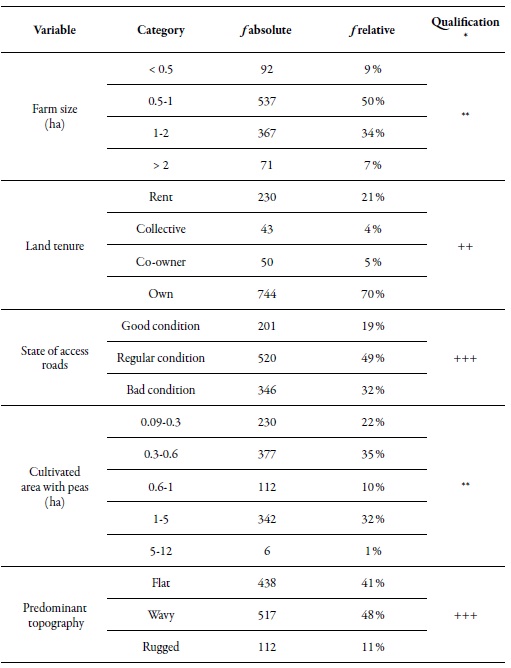
* Qualification: +++ = High, ++ = Medium, + = Low; ** Continuous variable (C.V. > 40 %).
Source: Elaborated by the authors
Nonetheless, it can be highlighted that only 14 % of the farmers have a source of water for agricultural use on the farm, of which 143 occasionally use irrigation through mechanical sprinklers. Under this scenario, the dependence on rainwater sources limits the productive capacity of the farm, food security, and income generation, for which specific evaluations and priority public measures for the subregion must be proposed.
On the farms assessed, the area destined for pea cultivation was variable, with reports ranging from 0.08 ha to 12 ha as indicated in table 2, a condition that was not only related to the size of the farm, but also to the practice of renting plots for agricultural production, which is later evidenced when clusters were generated.
Agricultural strateg y component
The application of edaphic fertilizers of industrial chemical synthesis was found in all the farms, of which 33 % also incorporated organic fertilizer and in 81 % of the cases the aspersion of foliar fertilizers for pea cultivation was also administered. This demonstrates the link that synthetic inputs have when used as a productive strategy in the region.
A similar situation was found for the management of phytosanitary problems, for which all the farmers carried out scheduled applications with commercial pesticide products. This dependence on inputs can be explained as a process stimulated by the productive model, in which agricultural companies with high incidence in the rural sector potentiate the need to purchase, as suggested by Forero (2013). Hence, the burden of external energy subsidies and possible problems of environmental contamination are linked to the green revolution agriculture model that increases the degree of vulnerability of the agricultural activity.
Concerning the productive strategies that employ a higher technological level adopted by the farmers, the use of soil analyses was only reported in 3 % of the cases, the use of irrigation was recorded in 13 % of the cases, and land preparation with equipment was related to the amount of pea to sow and the type of relief. These findings show that the adoption of technologies, inputs, and procedural rules in family farming is more associated with the financial capacity of the farm owner.
Another important aspect was the identification of the pea varieties that are normally planted in the study area (table 3) whose results agree with the official statistics of Nariño, where the variety San Isidro is predominant in Ipiales and Cuaspud, the Andina variety in Córdoba and Potosí, and the Santa Isabel variety predominates in Iles.
The previous results show that the farmers continue to depend on varieties released at the end of the 1990s, increasing the genetic specificity and the technological and cultural homogenization of the system. Furthermore, from the agroecological viewpoint –an alternative approach to agriculture– the pressure on local crops and materials, as well as the increase in vulnerability to biotic and abiotic factors that such homogeneity can generate is noticed.
It could also be observed that pea cultivation had a low turnover remaining in the plot between three and four semesters as reported by 62 % of the farmers interviewed, to then alternate with a cycle of potatoes, fallow or pastures, as shown in table 3. Some disturbing cases were found where crop rotation was postponed for more than two years, due to the extraction of nutrients and organic matter, and the increase in the inoculum of phytosanitary problems that may remain in the plot.
The previous productive context allows classifying the pea system within a traditional type of agriculture in accordance with Vélez and Gastó (1999), who identify it by the use of technology with limited scientific bases, with the possibility of causing degradation to the environment, lack of conservation practices, and with a property size that can be variable and generally located in difficult ecological conditions. Based on the information sought, an alternative form of agro-productive management could not be established in the region, such as organic or agroecological systems.
Social aspects component
The type of agriculture in the study area corresponds to a family model, whose social organization provides in each farm a substantial amount of labor related to daily work; likewise, the patrimony is collective, and the production is thought in terms of agricultural income (Forero, 2013; Forero et al., 2002). Furthermore, due to the large average size of the family, cooperation as a productive strategy is of vital importance (table 4).
The farm manager is male in 98.6 % of the cases agreeing with the study of Perilla (2014) in rural areas of the department of Nariño, where the author concluded that the role of men and women is marked. Men perform the productive and administrative tasks of the farm (e.g., crops and animal handling) and women are engaged in household chores, occupying many of her hours caring for the home garden (chagra) and minor species.
In the sample evaluated, the formal education level of the administrator was low, given that 11.3 % of the farmers interviewed had no studies and, when adding the primary and secondary level, 85 % of the cases were obtained (table 4). Different authors have indicated that this factor, together with age, can revert to less flexible behaviors when designing strategies to respond to changes in the agricultural sector or when adapting innovative production strategies. The previous information obeys in its totality to the masculine sample, and it is therefore why Perilla (2014) raises the need to inquire on the inequality that woman in the south of Nariño suffers; however, this was not considered in this research.
Environmental aspects component
The environmental component highlights the final destination of the synthetic fiber used in pea tutoring, that is a practice carried out by 99 % of the population interviewed. It was established that one hectare of pea requires between thirty and forty cones of 1 kg of synthetic material (approximately 3,000 linear meters of fiber per cone). Moreover, 84 %of the farmers indicated that after the productioncycle, they burned the material used; 9 % buriedthe fiber, and only 4 % reused it for another cycle(table 4). According to the statistics from the madr (2018), throughout the year the southernsubregion was able to generate an average of 348 tof synthetic fiber, for which there are no technicalmanagement measures.
Table 4. Results of the characterization survey for the social aspects component
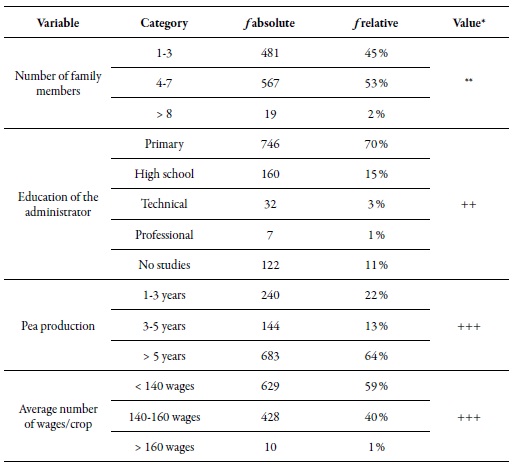
* Qualification: +++ =High, ++ =Medium, + =Low; ** Continuous variable (C.V. >40 %).
Source: Elaborated by the authors
Also, the results show once more the tutoring as a generator of environmental conflict, due to the pressure exerted on the local forest resource. For each hectare of pea, the structure employs an average of 1,660 wooden poles that, extrapolated to the needs of the southern subregion of Nariño, can reach a demand of 16.5 million poles, which have a useful life of three or four years. In order to obtain this resource required for pea cultivation in the evaluated sample, only 23 % of the farmers reported having forest patches that do not meet the need of the farm (table 5).
Given this scenario, it was essential to identify aspects of the system with environmental potential, of which fences with native shrubs were used as boundaries between farms, generating ecosystem services at the landscape level, composting for the home garden, and recycling the byproducts of the livestock subsystem. These strategies were practiced by 54 % of the farmers, as indicated in table 5, becoming rooted experiences that, when potentialized, can increase the environmental resilience and sustainability of the farm.
Economic aspects component
Regarding the economic aspects, it is specified that the variables assessed only allow knowing part of the interactions of the productive system. Further, the internal dimension of the farm that is different to pea cultivation but was stated by farmers as key, was not addressed, i.e., family labor, domestic resources, or interaction with other subsystems.
The performance was of great importance when forming the clusters since it indirectly integrated the socioeconomic systems (access to land, labor, capital, and technology). Furthermore, the estimation obeyed a quick method that allowed inquiring with the administrator in each farm about the number pea packages (bultos) harvested for each kilogram of planted seed. Then, these results were extrapolated to tons per hectare, establishing that the yield ranged between 3, 6 and 8.2 t/ha (table 6), and is comparable to those reported by madr (2018) in the study municipalities.
Besides, as indicated in table 6, the production cost extrapolated to one hectare of peas on average ranged between 5 and 9 million pesos per agricultural season, with substantial variations depending on the indebtedness capacity of the farmer, the environmental conditions and the distance to the commercialization point. Furthermore, this study drew attention to the fact that due to the excessive application of inputs as a productive strategy, in 7 % of the cases the production costs exceeded the amount of 9 million pesos, which was defined as a reference value, with reports of up to 11.6 million pesos for each hectare of pea. This is another determining factor when generating the clusters in the next stage of the research.
Table 6. Results of the characterization survey for the economic aspects component
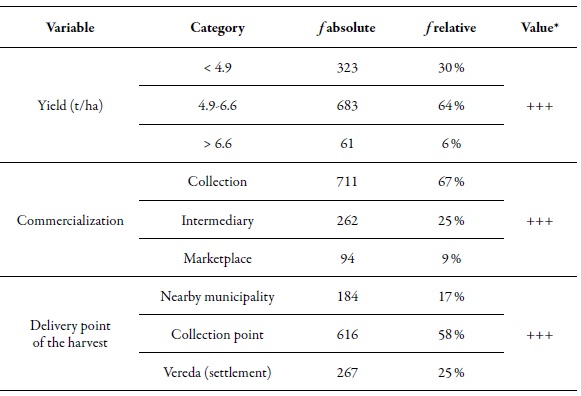
* Rating: +++ = High, ++ = Medium, + = Low. COP: Colombian pesos
Source: elaborated by the authors
Table 6 (cont.) Results of the characterization survey for the economic aspects component
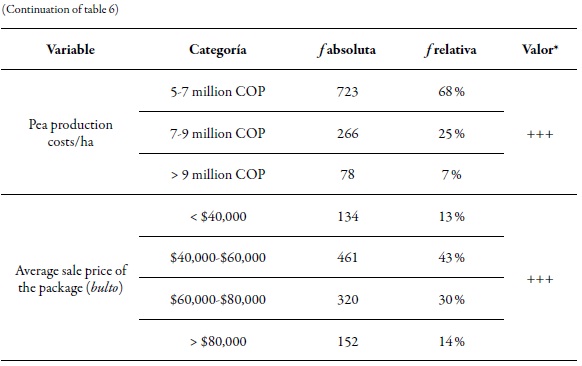
* Rating: +++ = High, ++ = Medium, + = Low. COP: Colombian pesos
Source: elaborated by the authors
It should be noted that this component highlights the mediation of the Agricultural Products Collection and Supply Central of Ipiales in the economic system of the region since it affects the destination, point of delivery and average sale price of the commercialized products indicated by the farmers. Solarte, Osorio and Checa (2016) established, from studies in this stockpiling center, that the final destination of peas is mainly the inland region, with the city of Bogota standing out with approximately 33 % of the transactions carried out, followed by Cali (27%), Pereira (24%), Medellín (12%) and Bucaramanga (4 %), with an average monthly offer of 33,949 packages, i.e., equivalent to 1,697 tons per month.
In this sense, when exchange relationships in the market are more or less stable, producers are more interested in specializing their activities in sale products. The analysis of the region indicates that these contributes to the decrease of farm diversification, the acceptance of market fluctuations and cope with high expenditure of external inputs represented in production costs.
Establishment and description of clusters
The individual contribution of the total variability factors and the eigenvalues resulting from the mca established nine factors, which accounted for 65.4 % of the data. The resulting dendrogram expressed the association of farms in three differentiated groups at a linkage distance of 0.05 units (figure 2); in addition, the suggestions of Madry et al. (2013) and Álvarez, Paas, Descheemaeker, Tittonell and Groot (2014), indicating that working with 3 to 4 clusters improves the accuracy of the resulting information was followed.
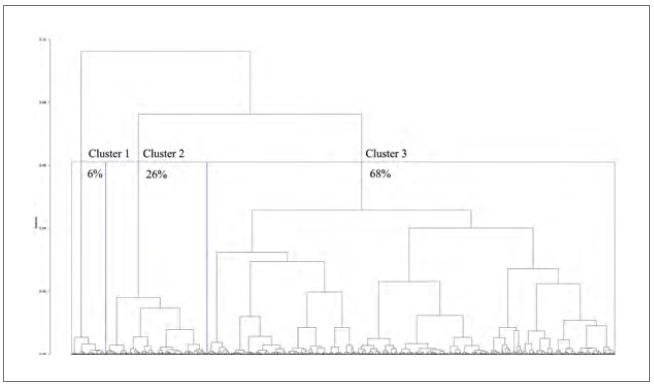
Source: Elaborated by the authors
Figure 2. Hierarchical grouping through the Ward algorithm method for pea producing farms in the southern subregion of the department of Nariño (n = 1,067).
The first cluster grouped 6 % of the total sample (68 farms); the second, 26 % (271 farms), and finally, the third one grouped 68% (728 farms). As indicated by Righi, Cittadini, Mundet, Martino, and Baltuska (2011), in the discrimination stage it is not unknown that there are other types of farms with different characteristics or needs, but rather the objectives of the research, the methodology and the variables selected that prioritize certain situations.
Each cluster was identified as an adaptation of the conventional agriculture approach associated with pea cultivation, showing that farmers create and make social, technological, and organizational decisions within the regional context. Like Goswami et al. (2014), it was established that the use of univariate methods to identify types of farms underestimate the existing diversity, ignoring the multidimensional relationship.
In table 7 are shown 13 variables as significant (P-value < 0.05) and highly significant (P-value < 0.01), which coincide with other classification studies in which, even under heterogeneous contexts, samples are selected by their differentiation characteristics at the farm system level, supporting the results obtained (Dos Santos, 2013; Goswami et al., 2014; Lores et al., 2008; Madry et al., 2010, 2013; Righi, Dogliotti, Stefanini & Pacini, 2011).
Cluster 1 (C1)
In table 7 is shown the statistical test performed on the variables that identify the first cluster. From this information, this group can be described as farmers with a farm size between 1 and 2 ha, with the possibility of renting plots, which allows cultivating peas in areas of 1 to 5 ha, grouping the cases with the largest area for the two variables. These characteristics have relevance in land property studies, since they reflect structural changes of the system and, especially, the differentiated relationship of socioeconomic exchange with the region according to Dos Santos (2013); proof of this is the hiring of labor force for the cropping work, exploiting resources with higher potential and generating surpluses for farm capitalization.
As an agro-productive strategy, the use of equipment for soil preparation was observed, having a direct impact on the number of wages that, on average, was less than 140 wages/ha. The primary rotation systems in this group were pastures used for smallscale dairy cattle activity and, as a second option, potato cultivation.
Además, este clúster presentó los mayores costos de producción debido al elevado uso de pesticidas y fertilizantes para la producción agrícola (> $9 millones/ha) que sostienen a su vez rendimientos entre 6,6 a 8,2 t/ha de arveja fresca, lo que muestra preocupación sobre la viabilidad de esta actividad desde el punto de vista ambiental, por realizarse bajo altos costes energéticos y presión sobre los recursos naturales.
In addition, this cluster presented the highest production costs due to the high use of pesticides and fertilizers for agricultural production (> $ 9 million COP/ha), which in turn supports yields between 6.6 to 8.2 t/ha of fresh peas. However, this practice generates concern about the viability of this activity from the environmental point of view, because it is carried out under high energy costs and pressure on natural resources.
Another important aspect was the access to markets for the sale of the harvest, as it is the most diverse of the three clusters. The sale at the Ipiales collection center is the first option, followed by direct marketing to wholesalers in the inland region of the country taking advantage of their vehicles and, finally, the sale in non-formal satellite points in the municipalities of Córdoba and Gualmatán. These results agree with the ones obtained by Solarte et al. (2016), who describe the commercialization strategies of the pea chain, making the precision that the satellite points are located on the roads where the farmers converge, in order to reduce the distance between the farm and the collection point, reducing the high cost represented by moving the harvest.
Table 7. Main cluster characteristics formed by pea-producing farms in the southern subregion of Nariño, Colombia
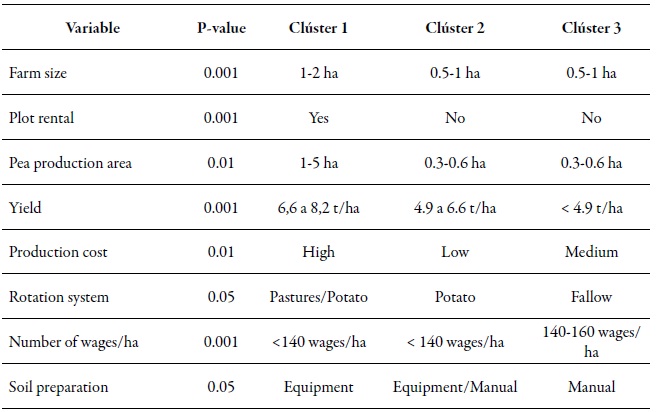
Source: Elaborated by the authors
Cluster 2 (C2)
In this group, the farm size varied between 0.5 and 1 ha, where peas are cultivated between 0.3 and 0.6 ha, occupying a high percentage of the total area of the farm (table 7). This characteristic caused the family to have a high dependence on agricultural production (sale and self-consumption); occasionally, the members of the family looked for complementary resources through labor supply.
The farms showed the best topographic conditions of the studied population, with access roads in good condition, and plots with lower slopes. This last factor had repercussions on the yield and production costs, recording harvests between 4.9 to 6.6 t/ha, with less use of inputs, lower requirement of wages to perform agricultural work (<140 wages/ha) and ease in the transportation of the harvest to the delivery point.
The primary rotation strategy used is sowing potatoes, which is preferred by the farmer because it can break the cycle of pests and diseases, in addition to reducing the costs of land preparation, since in the tuber harvest, the soil is removed allowing the direct sowing of the pea in the following semester.
The commercialization was developed in this cluster in two ways mainly: the first is related to the sale through established farmer-wholesaler channels outside the department of Nariño individually or associatively; and the second is related to the purchase to intermediaries that collect the harvest in the property.
For the second case, it has been indicated that this modality is recent in the region and can generate productive conflicts, given that the buyer resorts to monopolize the skilled labor in the harvest as a form of pressure for the product to be sold, as described by Solarte et al. (2016).
Cluster 3 (C3)
The third cluster included most of the farms evaluated in the sample, i.e., 68 %. The features shown in table 7 describe the cases with smaller property sizes, characterized by being in marginal areas of the region where the access roads are difficult to transit and, comparatively, are further away from urban centers and basic commercial exchange services.
The area dedicated to the production of peas ranged from 0.3 to 0.6 ha, and in these systems the family provides the total labor force for the agricultural work represented in the number of wages with a value between 140 to 160 wages/ha; in addition, the family members seek work outside the farm to meet the consumption needs, due to low internal profitability. Proof of this was the calculation of the harvests that were lower than 4.9 t /ha, with the lowest yield of the three clusters evaluated.
Another aspect linked to the size of the farm was the low crop rotation strategy, obtaining within a year four to six pea cycles followed by a period of fallow (rest), in order to maximize the economic entry of the main crop. Possibly, this practice, added to the topographic factors, increases the presence of phytosanitary problems, reflected in production costs between $ 7 and COP 9 million/ha, with a high percentage destined to the purchase and application of pesticides.
In relation to the above, Vélez and Gastó (1999) indicate that the geomorphology defined mainly by the slope can negatively or positively affect the degree of soil development, humidity, depth, and fertility; likewise, it is a factor that determines the technological receptivity and is used by these authors to generate land classification models. In this study, the topography also becomes a relevant discrimination feature between clusters, since it affects all the descriptive variables.
The commercialization in this group was carried out in the collection center. The difference with the first cluster is based on a lower sales volume, and is affected to a higher degree by the prices established by the supply and the demand that prevail at the time of the transaction. It was found that, in one day, the purchase value can vary between 10 and 30 %, generating high-income volatility, especially for this group.
Possibly, as this cluster shows major limitations to ensure family subsistence, these farmers sought in the diversification of species within the property represented in the "chagra" and the association with other producers in the same condition, a conservation strategy that must be evaluated in depth.
Considerations
The identification of the variations that the pea production system has at the farm level, as indicated by Vélez and Gastó (1999) and Álvarez et al. (2014), has particular relevance in the Andean zone, where a great diversity of farms and agricultural systems coexist. This complexity is originated by the objectives, technology, function, administration, interactions with nature, and socioeconomic functionality of the farmers, resulting in their response being heterogeneous, even within a seemingly similar region.
Moreover, the productive system is in different stages of development and adaptation, generating spatial and temporal variability that this research identified and classified at a specific time for the southern subregion of Nariño, in farms dedicated to the production of peas, suggesting to refer the period in which this research was developed for the interpretation and use of the results.
Based on the typology summarized in table 7, the specific actions in each of the clusters has been proposed to be developed, showing the initial bases that allows identifying strengths and weaknesses in each group, supporting policy planning decisions in a focused manner and, as a central objective of this research, generating a tool that can efficiently be used to make a rational and methodical selection of representative farms in the context of research projects, as suggested by Righi, Cittadini et al. (2011) and Righi, Dogliotti et al. (2011).
Finally, it is necessary to warn about an increasing homogenization of the productive process represented in pea cropping, the search for higher yields from the agronomic management of highly subsidized systems (fungicides, insecticides, herbicides, among others), the high consumption of nutrients, and the environmental pressure. As established in this research, these factors can lead to more significant externalities that increase the vulnerability of the system, diminishing socioeconomic autonomy and, especially, food sovereignty.
This scenario suggests evaluating the support capacity of the systems through the estimation of sustainability, especially when the classification results show three clusters that can respond differently in the social, environmental, economic and technical-productive dimensions in the region.
Conclusions
In the southern region of the department of Nariño, the agriculture associated with pea cultivation shows different variations and adaptations in terms of the characteristics of the farm and the interaction with the region. These particularities allowed us to describe the system and differentiate three clusters through the combination of multivariate statistical methods and confirmation in the field.
In all the cases, the agricultural developed showed high dependence on agricultural inputs, caused environmental impact, and showed a direct relationship between pea cultivation and family subsistence. At the same time, each cluster gathered particular characteristics regarding the farm, agro-productive strategies, and social, environmental, and economic aspects. The results obtained propose a methodical classification and raise questions about agroecological sustainability within the proposed clusters.
Acknowledgments
The authors thank the Governorate of Nariño and Fundación CeiBA for allowing the development of this research.
REFERENCES
Álvarez, S., Paas, W., Descheemaeker, K., Tittonell, P., & Groot, J. (2014). Construcción de tipologías, una forma de manejar la diversidad de las fincas: Directrices generales para Humidtropics. Wageningen, Países Bajos: Wageningen University. Recuperado de https://www.goo.gl/5yGoYQ [ Links ]
Departamento Administrativo Nacional de Estadística (DANE). (2011). Matriz de empleo en la base 2005 de las cuentas nacionales. Recuperado de https://www.goo.gl/bEHrfW [ Links ]
Dos Santos, M. (2013). Segmenting farms in the European Union. Agricultural Economics (Czech Republic), 59(2), 49-57. doi:10.17221/28/2012-AGRICECON. [ Links ]
Escobar, G., & Berdegué, J. (1990). Conceptos y metodología para la tipificación de sistemas de finca: La experiencia de RIMISP. En G. Escobar & J. Berdegué (Eds.), Tipificación de sistemas de producción agrícola (pp. 13-44). Santiago de Chile, Chile: Red Internacional de Metodología de Investigación de Sistemas de Producción. [ Links ]
Forero, J. (2013). The economy of family farming production. Cuadernos de Desarrollo Rural, 10(70), 27-45. Recuperado de: https://www.goo.gl/HpejXB [ Links ]
Forero, J., Torres, L., Ortiz, P., Durana, C., Galarza, J., ... Rudas, G. (2002). Sistemas de producción rurales en la región Andinacolombiana. Bogotá, Colombia: Pontificia Universidad Javeriana. [ Links ]
Goswami, R., Chatterjee, S., & Prasad, B. (2014). Farm types and their economic characterization in complex agro-ecosystems for informed extension intervention: study from coastal West Bengal, India. Agricultural and Food Economics, 2(1), 5. doi:10.1186/s40100-014-0005-2. [ Links ]
Hart, R. (1985). Sistemas agrícolas. En Centro Agronómico Tropical de Investigación y Enseñanza [CATIE] (Ed.), Conceptos básicos sobre agroecosistemas (pp. 33-44). Turrialba, Costa Rica: CATIE. [ Links ]
Lores, A., Leyva, A., & Varela, M. (2008). Los dominios de recomendaciones: Establecimiento e importancia para el análisis científico de los agroecosistemas. Cultivos Tropicales, 29(3), 5-10. Recuperado de https://www.goo.gl/QvWbvt [ Links ]
Madry, M., Gozdowski, D., Roszkowska, B., Dabrowski, M., & Lupa, W. (2010). Diversity and typology of farms according to farming system: a case study for a dairy region of Podlasie province, Poland. Electronic Journal of Polish Agricultural Universities, 13(2), 1-19. Recuperado de https://www.goo.gl/gfE85k [ Links ]
Madry, W., Mena, Y., Roszkowska-Madra, B., Gozdowski, D., Hryniewski, R., & Castel, J. M. (2013). An overview of farming system typology methodologies and its use in the study of pasture-based farming system: A review. Spanish Journal of Agricultural Research, 11(2), 316-326. Recuperado de https://www.revistas.inia.es/index.php/sjar/article/view/3295 [ Links ]
Ministerio de Agricultura y Desarrollo Rural (MADR) & Instituto Colombiano de Desarrollo Rural (INCODER). (2013). Resolución 1132 de 2013. Recuperado de https://www.goo.gl/9vyztG [ Links ]
Ministerio de Agricultura y Desarrollo Rural (MADR). (2018). Área Cosechada, Producción y Rendimiento de Arveja, 1986-2017. Recuperado de https://www.goo.gl/jHL4HK [ Links ]
Perilla, L. (2014). Los roles de las mujeres rurales en el departamento de Nariño, Colombia: Tendencias y cambios. Trabajo Social, 16, 187-204. Recuperado de https://www.bit.ly/2O87dNk [ Links ]
R Development Core Team. (2013). R: un lenguaje y entorno para el cálculo estadístico. R Fundación para la Computación de Estadística [software]. Recuperado de https://www.R-project.org [ Links ]
Righi, E., Cittadini, E. D., Mundet, C., Martino, L. S., & Baltuska, C. S. N. (2011). Tipología predial del sector productor de cerezas del sur de la Patagonia argentina. Agriscientia, 28(1), 85-97. Recuperado de https://www.goo.gl/L3JVBT [ Links ]
Righi, E., Dogliotti, S., Stefanini, F. M., & Pacini, G. C. (2011). Capturing farm diversity at regional level to up-scale farm level impact assessment of sustainable development options. Agriculture, Ecosystems and Environment, 142(1-2), 63-74. doi: https://doi.org/10.1016/j.agee.2010.07.011 [ Links ]
Solarte, R., Osorio, O., & Checa, O. (2016). Importancia del subsector productivo de arveja. Vitae, 23(Supl. 1), 844-848. Recuperdo de https://www.goo.gl/M5189y [ Links ]
Unidad de Planificación Rural Agropecuaria (UPRA). (2018). Departamento de Nariño. Recuperado de https://www.goo.gl/hGPEQa [ Links ]
Vélez, L., & Gastó, J. (1999). Metodología y determinación de los estilos de agricultura en escala predial. Ciencia e Investigación Agraria, 26(2), 75-99. doi:10.7764/rcia.v26i2.1066 [ Links ]
Received: September 24, 2018; Accepted: February 18, 2019











 texto en
texto en 


